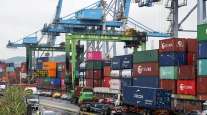Staff Reporter
US-Mexico Trade Trends Indicate Nearshoring Has Momentum

[Stay on top of transportation news: Get TTNews in your inbox.]
The post-pandemic trend toward nearshoring of trade is on course to finish the year strong despite an earlier slowdown in broader trade activity, a shift experts view as a prelude to longer-term change.
“While Mexico has surpassed China as the United States’ No. 1 trade partner, we’re really at the start of something much bigger,” said Richard Garza, executive sales director for Mexico cross-border operations at Total Quality Logistics. “Shifting production plants across the globe takes years, so the real impact is still years out. But in the last few months, changes have occurred that are preparatory in nature.”
Total Quality Logistics ranks No. 8 on the Transport Topics Top 100 list of the largest logistics companies in North America.
The U.S. Census Bureau reported Dec. 6 that imports from Mexico increased 6.3% year-over-year to $42.9 billion from $40.4 billion in October, while exports increased 6.7% year-over-year to $29.9 billion from $28 billion. This followed several months of tepid activity for cross-border activity in the second half of the year.
“ Nearshoring continues to go strong,” said Ben Enriquez, head of Mexico logistics and customs at Uber Freight. “We’re seeing more and more companies settling in across Mexico, primarily in the northern side of the country — in Monterrey, Saltillo and many Mexican border crossing points. We’re seeing less activity in the interior of the country.”
Laredo, Texas, has become a focal point of the nearshoring boom as a trade hub situated right on the border. TQL data showed that trade going through the city is up about 8% from last year, now making it the busiest trade port in the U.S. with growth expected to continue.

Garza
“Driving into Laredo and Monterrey, there are industrial parks that have recently sprung up,” Garza said. “Industrial real estate prices are moving up, vacancies are moving down and there are over 10 major highway improvement projects. Before the concept of nearshoring took off, U.S.-Mexico trade relations were already strong. The impact of nearshoring is going to put gas on that growth.”
Uber Freight data shows that around 75% of the nearshoring activity is coming to the northern territories of Mexico. Within that, about 50% of companies moving in are going to Monterrey, while 11% have settled in Saltillo. The rest are scattered around multiple points around the country.
“We know that each state in Mexico gives different advantages or benefits to the companies,” Enriquez said. “Many companies decide to choose the Mexican border crossing points like Juárez, Tijuana, Nuevo Laredo or Reynosa, because strategically it works for them, but also at the same time, being close to the border, it helps you mitigate transportation costs.”

Venetis
“We’ve seen cross-border activity steadily grow,” added Demetri Venetis, president of freight forwarding at RXO. “In addition to transportation growth, demand and interest in cross-border customs brokerage, transload and warehouse solutions through the RXO Laredo facility continue to increase. In Q3, RXO’s cross-border activity was up almost 40% year-over-year.”
But these gains have not come without challenges. Redwood Logistics released a report that found over $1 billion in freight and nearly 8,000 trailers have been disrupted at the Mexican border since September 2023. The report noted that a sharper focus on immigration enforcement has created a backlog like that experienced by seaports from 2020 through 2022.

RXO loading docks in Laredo. (RXO via YouTube)
Redwood Logistics ranks No. 52 on the TT100 logistics list.
Further expansion will help ease these constraints, said Jose Fernandez, vice president and Mexico country manager at BlueGrace Logistics.
“I think the greatest growth will come in the next couple of years once there [are] many more operations up and running in Mexico,” he said. “But there’s definitely been an increase. Also, there’s been an increase — contrary to what was expected — in loads coming southbound from the U.S. to Mexico because for pretty much the entire 2023 the exchange rate has been very atypical.”
Fernandez noted that the decreasing value of the U.S. dollar negatively impacted Mexican companies that export mainly to the U.S., but said the drop has helped those same companies take advantage of the favorable exchange rate to replace equipment.
BlueGrace ranks No. 73 on the TT100 logistics list.

Fillhouer
“Any kind of a slowdown that anybody might record or think is happening is just based on seasonality, and the retail season above all,” said Karl Fillhouer, vice president of sales at Circle Logistics. He also noted that Mexico benefited from the union strikes against U.S. automakers earlier this year since Mexican facilities remained operational.
Circle Logistics ranks No. 84 on the TT100 logistics list.
Fillhouer expects continued progress for the country once the freight market rebounds.
“Mexico is probably one of the quickest or fastest growing economies there is in the world,” he said. “Mostly because of the nearshoring and the fact that the U.S. is still considered the No. 1 economy worldwide.”
Want more news? Listen to today's daily briefing below or go here for more info:




